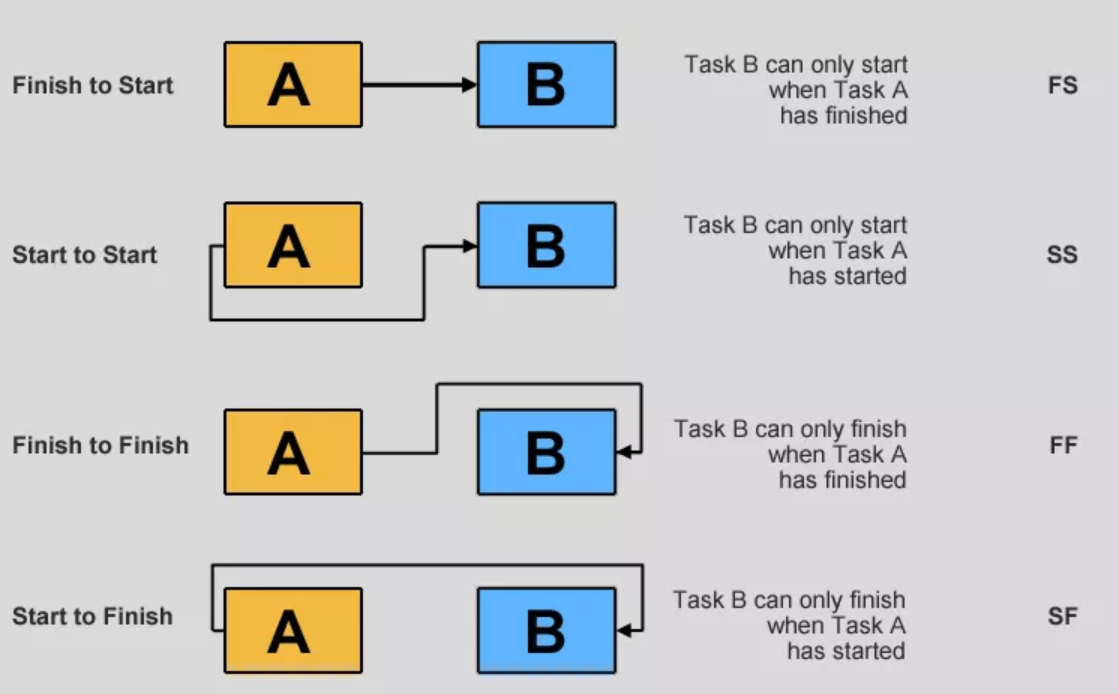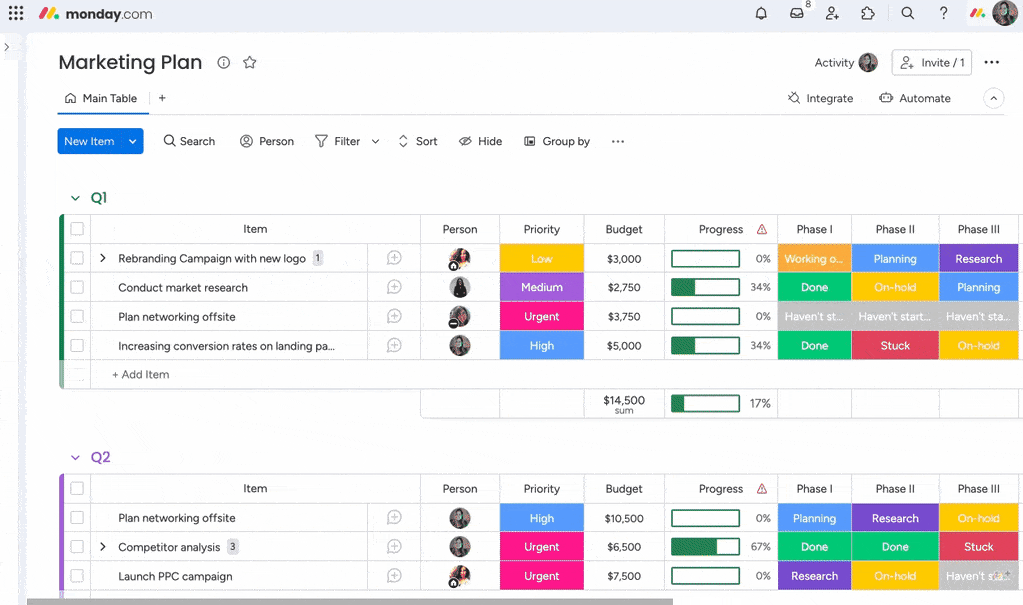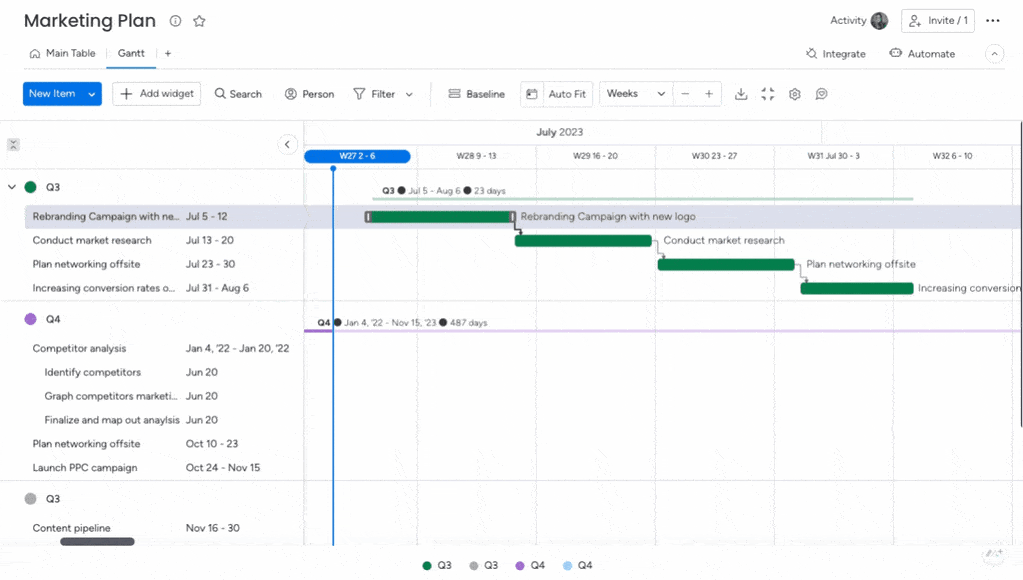Projects rarely comprise two simple tasks — they usually consist of numerous tasks and dependencies. Listing those items is one thing, but managing them in the correct sequence so your project runs like clockwork is another.
Thankfully, you can use project management software to help define, visualize, and manage your project dependencies so everything runs efficiently.
In this guide, we’ll answer some common questions related to task dependencies, share some tips for managing project dependencies, and show you how monday work management can help manage dependencies in project management.
What are task dependencies in project management?
In project management, dependencies refer to the relationships between tasks based on their sequence. A dependent task requires one or more other tasks to be completed or started before work can begin.
Identifying and handling dependencies is considered one of the most critical and consequential tasks in project management as it ensures teams complete work correctly and efficiently.
What are some examples of dependencies in project management?
Here are three examples of dependencies in project management:
- In software development, app testing is dependent on the completion of the app programming.
- In marketing, an ad campaign depends on the market research results.
- In construction, plastering depends on the plumbing and electrical teams completing their installations.
Key terms to know when looking at project dependencies
Two key terms to understand when discussing project dependencies are predecessor and successor.
A predecessor is an activity that must be completed before another activity can start or finish — i.e. it’s a task that potentially prevents other tasks from starting or ending.
On the other hand, a successor is an activity that follows another activity — i.e. it’s a task waiting on other tasks to start or finish.
Predecessors can have several direct successor activities, while successors can have several direct predecessor activities. Monitoring them throughout the project is crucial to ensure everything runs smoothly.
What are the 5 key dependencies in project management?
There are five key dependencies in project management comprising four internal sources — logic, resources, preferences, and cross-team dependencies — plus external factors.
- Logical dependencies: based on the logical sequence of tasks, where one task must be completed before another can start. For example, you need foundations laid before bricklaying commences.
- Resource dependencies: based on the availability of resources, where one task requires a specific resource — e.g. the same team member, equipment, or software — that is not available until another task is completed. For example, a joiner can’t fit the kitchen cabinets until he’s finished hanging the front door.
- Preferential dependencies: based on the preferences of stakeholders or team members, where one task is prioritized over another. For example, a project manager may decide to prioritize specific tasks over others, even though they are strictly dependent on each other.
- Cross-team dependencies: based on the work of other teams or departments, where one team’s work depends on the completion of another team’s work. For example, the sales team must wait for the R&D team to complete a product feature before launching it to customers.
- External dependencies: based on factors outside the control of the project team, such as weather events, bureaucracy, or legislature. For example, you need good weather to pour cement or a permit to park in a restricted zone.
In the next section, we’ll examine the different types of task dependencies. These are based on relationships rather than internal and external conditions.
What are the 4 types of relationship-based task dependencies in project management?
Projects can have dozens of dependencies, and the relationship between tasks can vary according to the project phase. Here are the most common types of task dependencies in project management.

- Finish to Start (FS): In this relationship, Task B — the successor — cannot start until its predecessor — Task A — has finished. As an example, the walls of a house can’t be built until the foundations are complete. To learn more about managing finish-to-start dependencies on monday.com, check out our Knowledge Base article on dependencies.
- Start to Start (SS): In this relationship, the successor can only start once the predecessor task it’s dependent on has started. For example, you can’t frost a cake if it hasn’t been baked. However, the cake doesn’t have to be finished baking before the chef starts — or finishes — the icing.
- Finish to Finish (FF): In this relationship, Task B can only finish when its predecessor — Task A — has also finished. For example, when an electrician wires a new house, the QA testing can’t be completed until all the wires are installed.
- Start to Finish (SF): In this relationship, the finish of the successor task is controlled by the start of the predecessor. For example, you can only finish billing the customer after the sales process has begun — i.e. they have confirmed the purchase.
How to identify task dependencies
To identify task dependencies in project management, you need to analyze the relationships between tasks and determine which tasks must be completed before others can start or finish. In other words, you need to consider your predecessors and successors. Here are some ways to identify task dependencies:
- Review the project scope and objectives: Understanding the project’s goals and objectives can help identify the tasks that must be completed and their order.
- Create a work breakdown structure (WBS): A WBS is a hierarchical breakdown of the project into smaller, more manageable components. It can help identify the tasks and their dependencies.
- Analyze the project schedule: The project schedule can help identify the tasks dependent on other tasks being completed first.
- Consult with subject matter experts (SMEs): An SME can provide insights into the tasks and their dependencies based on their experience and expertise.
- Use project management software: Project management software can help identify task dependencies and create a visual representation of the project schedule.
Why is it important to identify dependencies in project management?
Here are three reasons why it’s important to identify your project’s dependencies:
1. It increases the likelihood of on-time project delivery
Mismanagement of task dependency throughout the project timeline contributes to 12% of project failures. Identifying task dependencies is critical for building and managing the project schedule.
Once a team identifies all the project’s tasks, they can approximate each task’s duration. After sequencing the tasks according to their dependencies, you’ll see that some sequences are longer than others. The longest string of dependent tasks is called the critical path.
The critical path offers a realistic estimate of project duration and can be useful for managing stakeholder expectations for when a project is actually likely to be delivered.
For example, with monday work management, you can see a project timeline with its task dependencies:
2. It helps with resource management
Once you know what tasks must be completed and their estimated duration, allocating resources is much simpler.
Using an integrated platform like monday work management, you can easily create alignment between resource tracking and your project schedule. For example, you can even set up an automated email to contractors to confirm availability before work is due to start.
3. It helps with risk identification
Unfortunately, not all project tasks depend on things the project team can control. External dependencies can add significant risk to the project schedule.
It’s frustrating for project managers and team members alike to meet unexpected bottlenecks related to task dependencies, and it can cause timeline and resource challenges.
The best thing to do is flag external dependencies in the project risk register so business stakeholders know of any potential impact and can plan around those events.
Luckily, identifying dependencies doesn’t need to be a complicated process. With software like monday work management, you can visually organize, plan, and track every project task dependency in a few clicks.
Tips for managing project dependencies
Here are some tips for managing your project dependencies:
- Identify and document dependencies: Assess and document potential project dependencies, including their type, profile, specifications, timeline, and owner.
- Categorize dependencies: Categorize dependencies based on their type, such as logical, preferential, resource, cross-team, or external dependencies.
- Visualize dependencies: Use project management software to visualize task dependencies and create a visual representation of the project schedule.
- Reduce the number of dependencies: Where possible, reduce the number of dependencies by simplifying the project scope, breaking down tasks into smaller components, and eliminating unnecessary tasks.
- Communicate with stakeholders: Establish clear communication channels among team members to ensure everyone knows the dependencies and their impact on the project.
- Mitigate potential risks: Monitor dependencies throughout the project and plan for contingencies by identifying potential risks and developing a mitigation plan.
How monday.com can help you manage your task dependencies
At monday.com, we understand the importance of task dependencies — that’s why our work management platform includes the tools to help you manage them.
On your project board, you can edit task durations to visualize the impact on the critical path, adjust resource data, and even set up delay alerts. The ability to shift things around while maintaining connections between dependent tasks gives you fantastic flexibility throughout a project.
You can accomplish all this with one magic column.
The Dependency Column
On monday work management, you can use the Dependency Column to define the dependency relationships between the items on your board.

Once you’ve added the Dependency Column, you can choose the mode in which your dependencies will work — Flexible, Strict, or No action — and then the time column which your items will be dependent on — Date Column or Timeline Column:

Bonus: with the Strict dependency mode, you can also use the Lead and Lag feature to define any necessary delays or overlaps.
As you set up the dependencies between your items, you can select the dependency type for each individual relationship from Finish-to-start, Start-to-start, Finish-to-finish, and Start-to-finish.
For example, the item “Conduct market research” is dependent on the task “Rebranding Campaign with new logo” so you’d use a Finsh-to-start relationship, as shown in the Gantt chart:

Overall, the Dependency Column makes managing task dependencies in project management a breeze!
** Note: This column is available on our Pro and Enterprise plans.
Master your projects with a top-notch task dependency management platform
Managing task dependencies is one of the most crucial and consequential activities in project management as it ensures projects complete on time and within budget. With monday work management — built upon the robust monday.com Work OS — you can visually organize, plan, and track every project task dependency in a few clicks.

